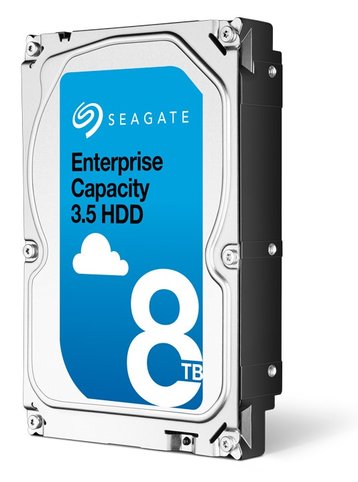Storage giant Seagate has announced three types of 8TB hard drives aimed at different use cases in the data center.
Seagate Enterprise Capacity 3.5 HDD offers a balance of speed and reliability, and looks like a work horse for business applications.
Seagate Enterprise NAS HDD will deliver less performance than the Capacity model but will presumably carry a lower price tag.
Seagate Kinetic HDD puts Ethernet connectivity and object storage protocol directly into the drive. It was designed for the Kinetic Open Storage platform, offering a new approach to managing hard drives across large deployments.
“Customers today need storage solutions to support a diverse, and sometimes very specialized, set of applications and workload requirements,” said Scott Horn, vice president of marketing at Seagate.
“In designing our products, we look closely at the type of data being stored, performance needs, power requirements, environmental operating conditions, network topologies, uptime demand and more, to ensure our customers receive the right storage technology for the job.”
The company also set a new record for aerial density – the amount of magnetic tracks that can fit onto a single platter – with a new 2TB drive that’s only 7mm thin.
A place for everything and everything in its place
Seagate was the first hard drive vendor to launch a working 8TB device, but its Archive HDD relied on a technique called Shingle Magnetic Recording (SMR), which boosted capacity at the expense of write speed.
The new Seagate Enterprise Capacity 3.5 HDD uses conventional magnetic recording technology - this means no shingles, helium, lasers or any other engineering tricks manufacturers have developed to increase storage space. It will be available with either SAS or SATA support, and feature a large 256MB cache together with power loss protection.
“With Seagate’s new portfolio of 8TB 3.5” Enterprise and Kinetic HDD we can cost-effectively address expanding web scale storage requirements with the most advanced Green Computing platforms on the market,” said Don Clegg, vice president of marketing and business development for server manufacturer Supermicro.
Seagate Enterprise NAS HDD also features a 256MB cache, but the interface choice is limited to SATA. This drive was designed to work in RAID configurations and is more likely to produce errors – something that’s not a problem when all data is duplicated on a nearby drive.
Seagate Kinetic HDD will feature SMR technology and a host of innovations that would interest the company’s largest customers. To put it simply, the Kinetic Open Storage Platform aims to reduce the need for traditional storage servers, replacing them with boxes full of Ethernet switches and Ethernet-controlled drives.
“I am impressed by the disk capacity increase achieved by Seagate,” said Dirk Duellmann, deputy leader of the data and storage services group in the IT department at CERN. “As part of our collaboration through CERN openlab, we are aiming to demonstrate with Seagate the expected TCO and scalability benefits of Kinetic drives. These tests are being performed within the 100PB-scale storage setups that CERN deploys for the Large Hadron Collider.”
All drives are currently sampling to select customers with general availability planned for later this year.

